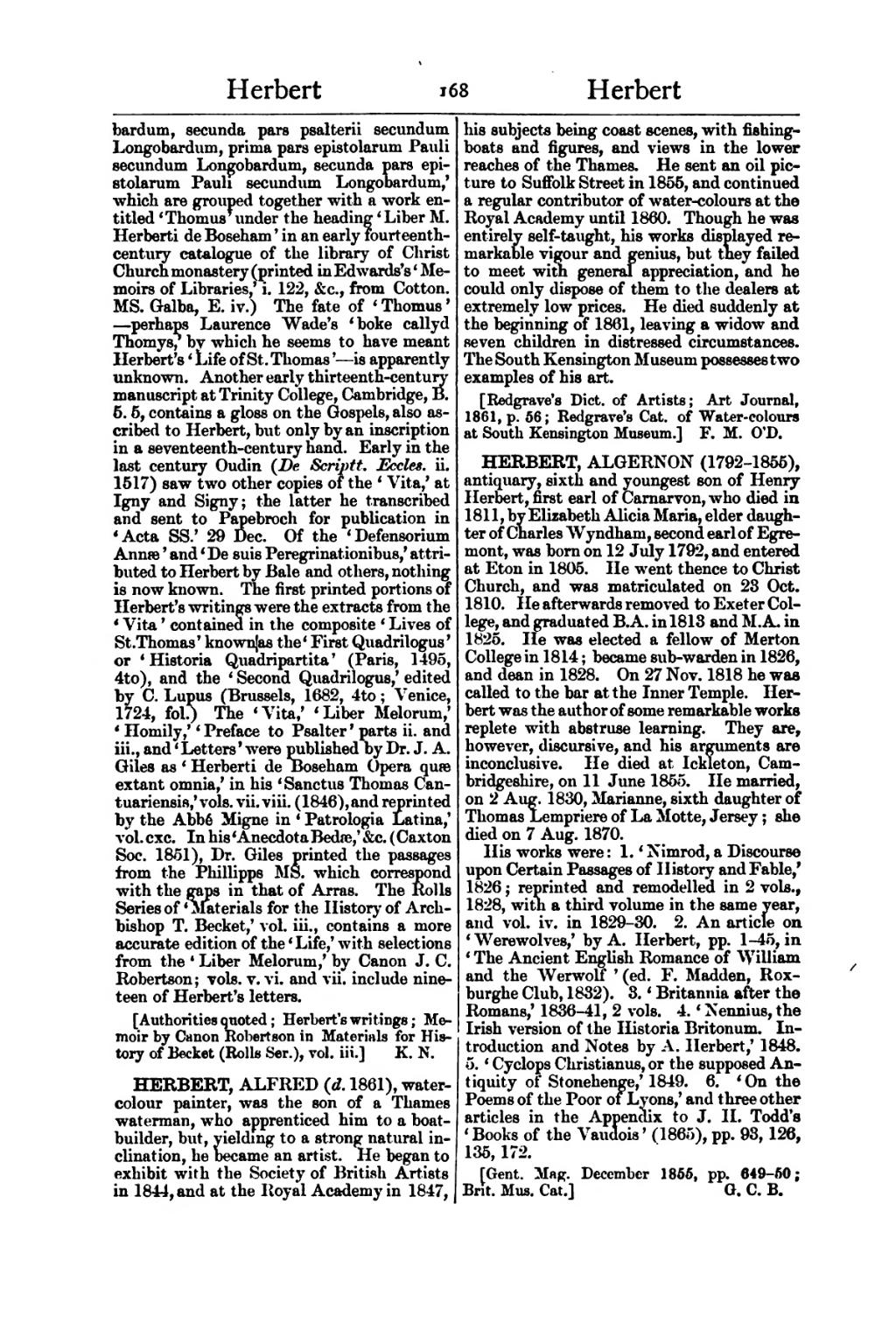bardum, secunda pars psalterii secundum Longobardum, prima pars epistolarum Pauli secundum Longobardum, secunda pars epistolarum Pauli secundum Longobardum,’ which are grouped together with a work entitled ‘Thomus’ under the heading ‘Liber M. Herberti de Boseham’ in an early fourteenth century catalogue of the library of Christ Church monastery (printed in Edwards's ‘Memoirs of Libraries,’ i. 122, &.c., from Cotton. MS. Galba, E. iv.) The fate of ‘Thomus’ —perhaps Laurence Wade's ‘boke callyd Thomys,’ by which he seems to have meant Herbert's ‘Life of St. Thomas’—is apparently unknown. Another early thirteenth-century manuscript at Trinity College, Cambridge, B.5.5, contains a gloss on the Gospels, also ascribed to Herbert, but only by an inscription in a seventeenth-century hand. Early in the last century Oudin (De Scriptt. Eccles. ii. 1517) saw two other copies of the ‘Vita,’ at Igny and Signy; the latter he transcribed and sent to Papebroch for publication in ‘Acta SS.’ 29 Dec. Of the ‘Defensorium Annæ’ and ‘De suis Peregrinationibus,’ attributed to Herbert by Bale and others, nothing is now known. The first printed portions of Herbert's writings were the extracts from the ‘Vita’ contained in the composite ‘Lives of St.Thomas’ known as the ‘First Quadrilogus’ or ‘Historia Quadripartita’ (Paris, 1495, 4to), and the ‘Second Quadrilogus,’ edited by C. Lupus (Brussels, 1682, 4to; Venice, 1724, fol.) The ‘Vita,’ ‘Liber Melorum,’ ‘Homily,’ ‘Preface to Psalter’ parts ii. and iii., and ‘Letters’ were published by Dr. J. A. Giles as ‘Herberti de Boseham Opera quæ extant omnia,’ in his ‘Sanctus Thomas Cantuariensis,’vols. vii.viii. (1846), and reprinted by the Abbé Migne in ‘Patrologia Latina,’ vol.cxc. In his ‘Anecdota Bedæ.’ &c. (Caxton Soc. 1851), Dr. Giles printed the passages from the Phillipps MS. which correspond with the gaps in that of Arras. The Rolls Series of ‘Materials for the History of Archbishop T. Becket,’ vol. iii., contains a more accurate edition of the ‘Life,’ with selections from the ‘Liber Melorum,’ by Canon J. C. Robertson; vols. v. vi. and vii. include nineteen of Herbert's letters.
[Authorities quoted; Herbert's writings; Memoir by Canon Robertson in Materials for History of Becket (Rolls Ser.), vol. iii.]
HERBERT, ALFRED (d. 1861), watercolour painter, was the son of a Thames waterman, who apprenticed him to a boatbuilder, but, yielding to a strong natural inclination, he became an artist. He began to exhibit with the Society of British Artists in 1844, and at the Royal Academy in 1847, his subjects being coast scenes, with fishing-boats and figures, and views in the lower reaches of the Thames. He sent an oil picture to Suffolk Street in 1855, and continued a regular contributor of water-colours at the Royal Academy until 1860. Though he was entirely self-taught, his works displayed remarkable vigour and genius, but they failed to meet with general appreciation, and he could only dispose of them to the dealers at extremely low prices. He died suddenly at the beginning of 1861, leaving a widow and seven children in distressed circumstances. The South Kensington Museum possesses two examples of his art.
[Redgrave's Dict. of Artists; Art Journal, 1861, p. 56; Redgrave's Cat. of Water-colours at South Kensington Museum.]
HERBERT, ALGERNON (1792–1855), antiquary, sixth and youngest son of Henry Herbert, first earl of Carnarvon, who died in 1811, by Elizabeth Alicia Maria, elder daughter of Charles Wyndham, second earl of Egremont, was born on 12 July 1792, and entered at Eton in 1805. He went thence to Christ Church, and was matriculated on 23 Oct. 1810. He afterwards removed to Exeter College, and graduated B.A. in 1813 and M.A. in 1825. He was elected a fellow of Merton College in 1814; became sub-warden in 1826, and dean in 1828. On 27 Nov. 1818 he was called to the bar at the Inner Temple. Herbert was the author of some remarkable works replete with abstruse learning. They are, however, discursive, and his arguments are inconclusive. He died at Ickleton, Cambridgeshire, on 11 June 1855. He married, on 2 Aug. 1830, Marianne, sixth daughter of Thomas Lempriere of La Motte, Jersey; she died on 7 Aug. 1870.
His works were: 1. ‘Nimrod, a Discourse upon Certain Passages of History and Fable,’ 1826; reprinted and remodelled in 2 vols., 1828, with a third volume in the same year, and vol. iv. in 1829-30. 2. An article on ‘Werewolves,’ by A. Herbert, pp. 1-45, in ‘The Ancient English Romance of William and the Werwolf’ (ed. F. Madden, Roxburghe Club, 1832). 3. ‘Britannia after the Romans,’ 1836-41, 2 vols. 4. ‘Nennius, the Irish version of the Historia Britonum. Introduction and Notes by A. Herbert,’ 1848. 5. ‘Cyclops Christianus, or the supposed Antiquity of Stonehenge,’ 1849. 6. ‘On the Poems of the Poor of Lyons,’ and three other articles in the Appendix to J. H. Todd's ‘Books of the Vaudois’ (1865), pp. 93, 126, 135, 172.
[Gent. Mag. December 1855, pp. 649-50; Brit. Mus. Cat.]
